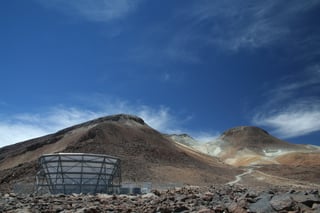The Atacama Cosmology Telescope (ACT) is a cosmological millimeter-wave telescope located on Cerro Toco in the Atacama Desert in the north of Chile. ACT makes high-sensitivity, arcminute resolution, microwave-wavelength surveys of the sky in order to study the cosmic microwave background radiation (CMB), the relic radiation left by the Big Bang process. Located 40 km from San Pedro de Atacama, at an altitude of 5,190 metres (17,030 ft), it is one of the highest ground-based telescopes in the world. Cosmic microwave background experiments like ACT, the South Pole Telescope, the WMAP satellite, and the Planck satellite have provided foundational evidence for the standard Lambda-CDM model of cosmology. ACT first detected seven acoustic peaks in the power spectrum of the CMB, discovered the most extreme galaxy cluster and made the first statistical detection of the motions of clusters of galaxies via the pairwise kinematic Sunyaev-Zeldovich Effect. ACT was buit in 2007 and saw first light on October 2007 with its first receiver, the Millimeter Bolometer Array Camera (MBAC). ACT has had two major receiver upgrades which enabled polarization sensitive observations: ACTPol (2013-2016) and Advanced ACT (2017-2022). ACT observed for the last time in 2022. ACT is funded by the US National Science Foundation. From Wikipedia
